Affordable Care Act enrollment expected to hit another record
When we started Nimble Reporting we knew we were taking a chance. WIth every election we wondered if the Affordable Care Act would be replaced with something else. We knew that if ACA could withstand a partisan assault or worse an assault by the economy, there would be a good chance it would stick for good. Well we won that bet and moreover the American public won a system that truly does try to control spiraling healthcare costs. ACA has obviously taken hold and this year, it will hit another record of Americans who have decided that it is the best way for them to control what for some families is their biggest expense. And we’re glad we could bring a best-of-breed product to protect those entities that help the public handle ACA.
FROM MARKETPLACE / BY BLAKE FARMER
Americans started thinking a bit differently about work during the pandemic. Priorities shifted; many struck out on their own.
Titus Prather of Nashville, 24, is ready to join the growing ranks of the self-employed.
“I’ve been in construction four years now,” he said. “But I’m actually getting ready to transition to working for myself, so I can start building my own construction company.”
Prather is hoping to build custom homes here in Nashville, where the housing market is still juiced from the last few years. But to cash in on the local real estate boom, he needs to make sure medical bills don’t eat all his profits.
About a decade into the Affordable Care Act marketplace, the individual health plan exchange seems to be finally hitting its stride. A record number of Americans, 14.5 million, bought plans for this year. And with open enrollment underway now — ending Jan. 15 for the federal marketplace — the upward trend is expected to continue, related to several lingering effects of the pandemic.
On the day the open enrollment period began, Nov. 1, Prather met with a health plan navigator to lock down a policy for his growing family.
“And I have a baby soon, so just making sure I have everything in order for my family,” Prather said.
Deadlines vary from state to state, but Prather has until Jan. 15 to get all his paperwork in to lock down a subsidized plan. Nearly three-quarters of people who sign up qualify for discounted monthly premiums — which dropped last year to an average of $133 a month.
But it’s not just the self-employment boom pushing people to buy these plans. It’s also some fear created by COVID.
“The pandemic did not discriminate,” said Aida Whitfield, who oversees Obamacare navigators in Tennessee.
When Affordable Care Act plans first became available, a lot of young and healthy people didn’t think it was worth signing up for. This hardheaded bunch even earned the nickname “young invincibles.” But many are feeling a bit less invincible these days.
“For a lot of young people, also seeing other young people going through the pandemic and having COVID and going through the worst part of it, I think makes them realize, ‘OK, it could be me tomorrow,’” Whitfield said.
More generous subsidies are also making Obamacare plans more attractive, and they’ve been extended through at least 2025.
Another factor at play this year making analysts think numbers on the ACA exchange will continue to climb is a tweak in the regulations for what was known as the “family glitch.”
“Basically there had been some people — mostly spouses and children of people who had employer coverage — who had been blocked from getting subsidies,” said Cynthia Cox, director of the program on the ACA at the Kaiser Family Foundation.
If your spouse had a job that offered insurance for the whole family — even if it was expensive — you couldn’t get the big discounts. Now, that’s changed. Another million people may come into the market for just this reason, Cox said.
The more entrepreneurs, young healthy people or families on the marketplace, the more stable it will become long into the future, she said. The Obamacare individual market got off to a rocky start. Cox has been following from the beginning.
“Definitely in the first couple of years of these markets being open, there was a lot of volatility,” she said. “Premiums went up a lot. Insurers were exiting the market. There were some counties in the U.S. where it wasn’t even clear if there was going to be a single insurer offering this coverage. But that all has passed.”

